BREAST AUGMENTATION By Joshua Zuckerman, MD, FACS in New York City



Breast augmentation by Dr. Zuckerman, patient female, 1 year post-op. Submuscular implacement, Inframammary fold incision.
Introduction to Breast Augmentation
Dr. Zuckerman is an expert in breast augmentation, and it is one of the most common surgical procedures that he performs in his practice in midtown Manhattan. Breast augmentation is also the most popular cosmetic surgery in the United States with over 300,000 procedures performed per year, according to statistics from the American Society of Plastic Surgeons (ASPS). Dr. Zuckerman has gained valuable insight from breast augmentation patients over the years and understands how central a woman’s feelings about her breasts are to her self-confidence and view of her own femininity. Whether you desire a large augmentation or a subtle enhancement, Dr. Zuckerman will customize his approach to your personal surgical goals to attain the best outcome for you. Breast augmentation is most commonly performed through the placement of breast implants, which today are extremely safe and can produce a natural-looking, youthful, fuller, more sensual enhancement that is proportionate to your body’s frame. There are several decisions that Dr. Zuckerman will help you make including type, size, incision location, corrective action if needed for breast asymmetry, etc. In the guide below, learn more about each of these aspects. Dr. Zuckerman has also included answers to many common preoperative questions that he has received from patients over time. He seeks to minimize downtime for patients using a revolutionary long-acting pain management agent and to minimize ultimate surgical scarring. As part of his breast augmentations, Dr. Zuckerman provides a comprehensive postoperative scar care regimen for up to one year after surgery. Dr. Zuckerman trained at some of the most elite institutions in the world including Brown University and NYU, and he is dedicated to achieving breasts that are beautiful, both natural-looking and feeling, and symmetrical.
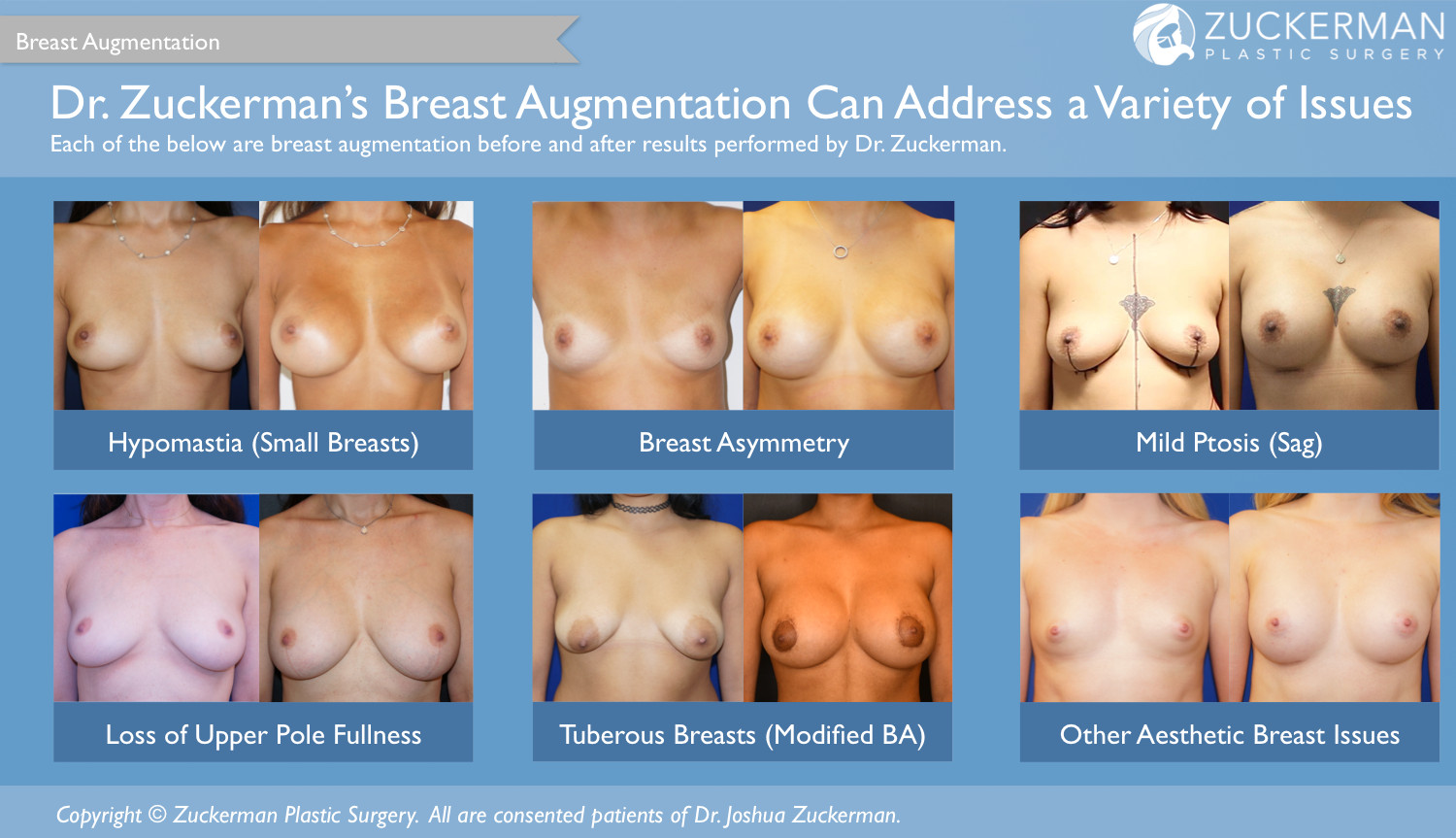
Dr. Zuckerman can address several aesthetic issues of the breasts via breast augmentation surgery as demonstrated by this collection of his before and afters.
Good candidates for breast augmentation are typically women who desire a more shapely bustline, larger breasts and appealing decolletage. Breast augmentation can also address changes in breast shape or size after pregnancy, breastfeeding, or surgery. Augmentation is common method of reconstruction after surgical breast cancer treatment. Patients come to Dr. Zuckerman seeking to address a variety of aesthetic issues including breast size, asymmetry, shape and droopiness. Breast augmentations can also be performed in a wide variety of sizes ranging from subtle to large, and breast implants are available to meet most patients’ needs or can be specialty ordered. Dr. Zuckerman strives to achieve high-quality surgical outcomes for all of these distinct surgical goals.
Adult patients of most ages and weights are eligible for this surgery. However, the minimum age for for saline implants is 18 and for silicone is 22. Dr. Zuckerman recommends that your breasts be finished developing to ensure the best result. For older patients, you must be in good overall health and be able to obtain medical clearance to undergo general anesthesia.
If you have already undergone a breast augmentation with another surgeon and seek corrective surgery with Dr. Zuckerman, please visit our revision breast surgery guide. Dr. Zuckerman is often asked by patients and other surgeons alike to perform, sometimes complex, corrective breast surgery, but secondary surgery is more intensive than primary augmentation and has unique aspects.
Follow one of Dr. Zuckerman’s breast augmentation patients before, during and after surgery. Dr. Zuckerman placed 300cc Mentor MemoryGel round, smooth silicone implants submuscular through an inframammary fold incision.
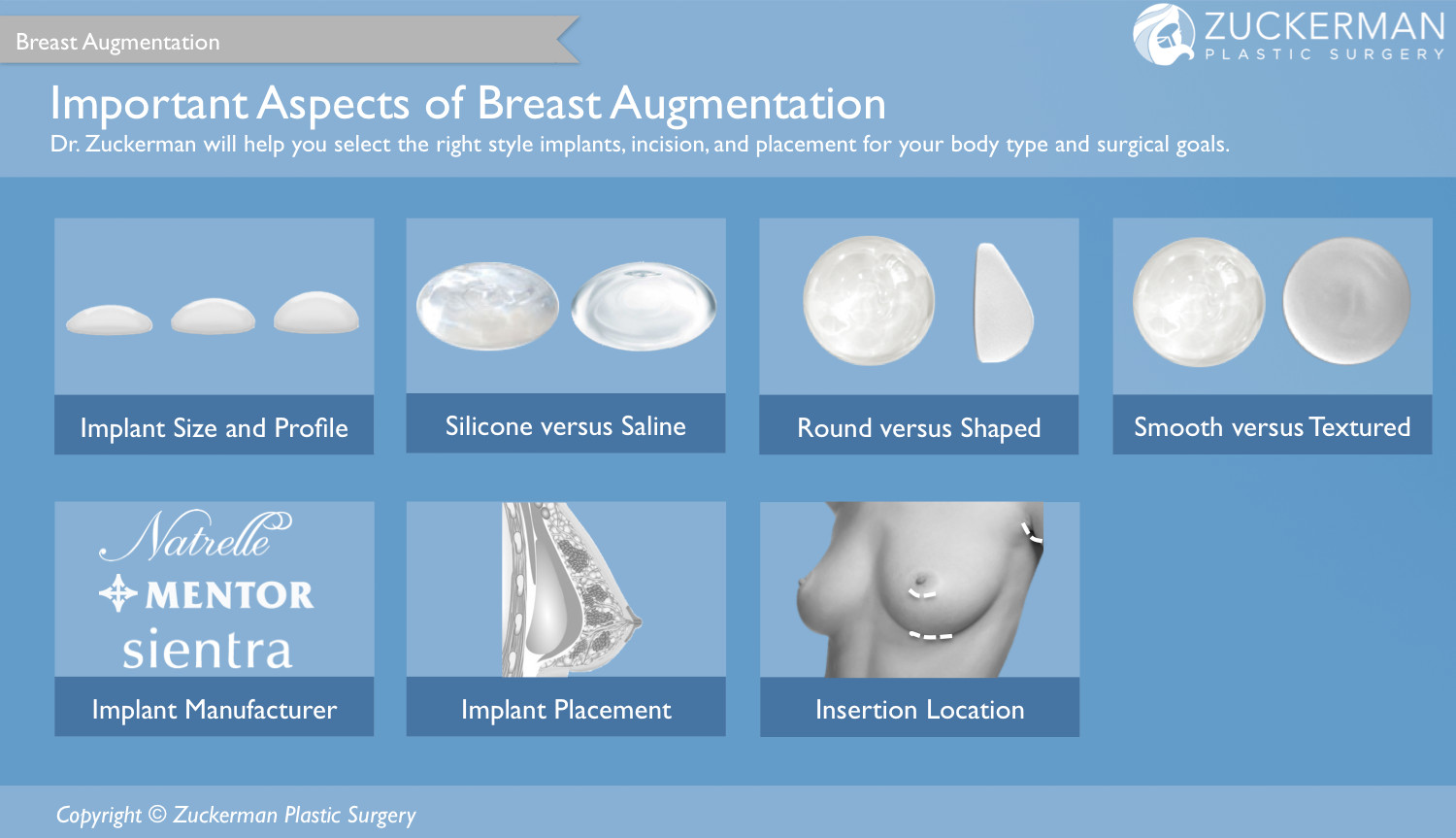
Dr. Zuckerman will help you determine the best approach for your breast augmentation. Visit the breast implants selection guide for more information as to which implant may best suit you.
Every woman’s preoperative anatomy is unique, as are her surgical goals, and Dr. Zuckerman customizes each procedure to the individual. Before surgery, Dr. Zuckerman will walk you through the key choices required to determine the approach to your augmentation, which will be based on your surgical goals, body frame, starting amount of breast tissue, and medical history. Visit our guide for more information on selecting the breast implants for your procedure. Dr. Zuckerman is also happy to address any and all other concerns or questions you may have at your breast augmentation cosmetic consultation.
Surgical Incision Locations for Breast Augmentation
Dr. Zuckerman performs all three kinds of the commonly used breast augmentation techniques. He will make a recommendation to you based on your level of existing breast tissue and other criteria. The most common incision he employs is the inframammary fold incision, but he is happy to use any of the three incision placements if you have a preference. After discussion with you about your goals including the potential for future breastfeeding, you will together finalize the technique Dr. Zuckerman will use during your breast augmentation surgery.
Periareolar Incision
The periareolar incision is made along the border of the more darkly pigmented tissue of the aereola and is well-concealed. However, since it involves cutting through breast issue, it is associated with a higher risk of breast feeding difficulties or changes in breast or nipple sensation than other incision sites, although these complications are rare.
Inframammary Incision
The inframammary incision is concealed in the fold beneath the breast. It is generally less concealed than periareolar and is associated with less breast feeding difficulties than the periareolar incision site. It is also the most incision site in use today, and Dr. Zuckerman feels that it gives the best control of the breast pocket, which is important for the quality of the overall aesthetic result.
Transaxillary Incision
The transaxillary incision is hidden in a fold of the armpit. This approach involves either a probe fitted with a miniature camera or blind dissection and is more difficult than the others. It allows the surgeon less control of the implant during insertion.

Dr. Zuckerman will make a recommendation as to the best-suited incision location and implant placement for your procedure.
Placement of the Implant during Breast Augmentation
There are also three possible placements of the breast implants relative to the breast anatomy that are used in breast augmentation. Dr. Zuckerman often performs the submuscular placement, but the choice depends on the patient’s anatomy and preferences. The differences in placement are due to positioning of the implant versus the pectoralis major muscle. Dr. Zuckerman will make a placement recommendation to you based on your goals and initial level of breast tissue, but he does perform all three. You will discuss with him at your initial consultation and finalize the decision together.
Submuscular Placement
For the submuscular placement, Dr. Zuckerman makes the breast pocket underneath the pectoralis major muscle. It is the most common placement that Dr. Zuckerman performs and is most common nationwide. It is a simple placement, with a relatively bloodless dissection plane. This placement puts good tissue over the implant, and there is some thought among plastic surgeons that it has lower risk of capsular contracture.
Subglandular Placement
For the subglandular placement, Dr. Zuckerman makes the breast pocket underneath the breast gland but on top of the pectoralis major muscle. This placement has fallen out of favor somewhat, but it is a matter of preference for the surgeon. If the patient has a very muscular chest wall, Dr. Zuckerman may recommend avoiding the submuscular placement in favor of the sublandular. Dr. Zuckerman has also recommended this to patients with little natural breast issue. This is the original placement location and was favored in the 1980’s.
Dual-Plane Placement
For the dual-plane placement, Dr. Zuckerman makes the breast pocket under the pectoralis major muscle, similar to a submuscular placement, and then frees up the interface between breast gland and the muscle so that the implant slides. In this placement, the implant contacts the bottom part of the breast gland, which hinges the breast mound and tissue to give a small lift to the breasts. There are three variations of this technique depending on how much of the interface vertically is freed up, and which variation to choose depends on how much lift you would like to achieve. However, this placement cannot be used in place of a breast lift (mastopexy).
Breast Augmentation Procedure
During surgery, Dr. Zuckerman makes an initial breast incision as detailed in the section above and creates a pocket inside the breast to hold the breast implant. He then places temporary sizers into the pocket and inflates them to various sizes. Dr. Zuckerman brings multiple sets of implants to the operating room. Only after seeing the impact of different possible augmentations using the temporary sizers and carefully considering the patient’s goals does he open one set of implants for placement. Dr. Zuckerman believes that this initial sizing step is key to producing good breast augmentation results and happy patients. No matter how precise his preoperative measurements of the breasts and body frame, there is no substitute for physically evaluating a possible result with exact sizing. In addition, this step ensures that Dr. Zuckerman has appropriately placed each breast pocket to account for any breast asymmetry, which is common. Dr. Zuckerman then removes the temporary sizers and places the permanent set of implants using the no-touch technique described below. Afterward, Dr. Zuckerman closes the incision with multiple layers of stitches to minimize the ultimate scar.
Dr. Zuckerman typically completes breast augmentation surgery in approximately two hours and performs it under general anesthesia. You may undergo breast augmentation surgery on an out-patient basis at Dr. Zuckerman’s state-of-the-art, fully equipped operating room located inside his office in midtown Manhattan. This operatory facility has been certified by the American Association for Accreditation of Ambulatory Surgery Facilities, Inc. (AAAASF), certifying it as a facility that offers an equally high standard of care as a hospital. The privacy, discretion, and convenience of Dr. Zuckerman’s private in-office operating room facility is an exclusive benefit of Zuckerman Plastic Surgery that many patients appreciate. Should you desire, you may also undergo surgery with Dr. Zuckerman at Manhattan Eye, Ear & Throat Hospital, a major hospital in Manhattan in the Northwell system where all types of breast, body, and face cosmetic surgery procedures are performed. Dr. Zuckerman is on staff in the department of plastic surgery for Northwell system hospitals in Manhattan among others.
Breast Augmentation Using a No-Touch Technique
To place the breast implant without touching it, Dr. Zuckerman uses a “no-touch” technique involving a specially coated plastic sleeve called the Keller funnel to maximize sterility. He also performs a handful of other resterilization techniques on the already sterile surgical field including irrigating the breast pocket with antibiotics and changing his surgical gloves immediately before placement. These extra measures are important, because it is thought that bacterial contamination may contribute to a type of complication called capsular contracture. Although relatively uncommon, patients should be aware of this potential complication, and Dr. Zuckerman feels it is imperative to take every possible measure to minimize its probability.
Aug/Pexy: A combined Breast Augmentation and Lift
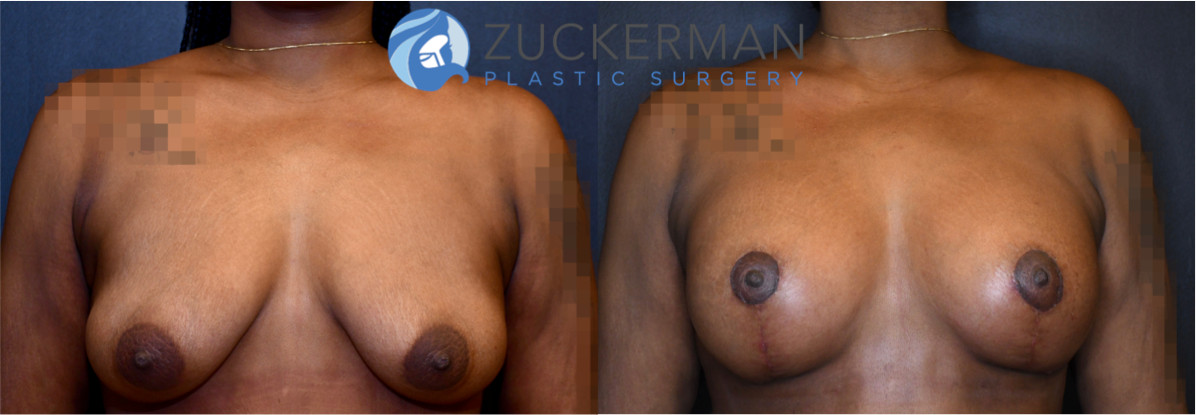
Combined breast augmentation and breast lift (mastopexy) by Dr. Zuckerman. Patient pictured before surgery and 2 months postop. 275cc round silicone implants placed.
Breast augmentation can be combined with a breast lift (mastopexy) to give the breasts a more “perky” aesthetic. This combination may be a good option for those desiring an increase in breast size or upper pole fullness in addition to eliminating ptosis or sag. After cessation of breastfeeding, weight loss, or aging, the breasts may begin to exhibit sag. The degree of ptosis varies greatly, and Dr. Zuckerman may be able to address mild sag without performing a mastopexy. If a breast augmentation alone is performed where a mastopexy is actually needed, the final aesthetic result may be compromised, and the breasts may not look natural or may sag off the implants. Performing both procedures at once does add operative time but can still be performed at Dr. Zuckerman’s accredited in-office operating facility. Please inquire at your cosmetic consultation with Dr. Zuckerman if this combination may be right for you.
Dr. Zuckerman uses several techniques to minimize swelling and downtime after surgery, offering what is often informally called “rapid recovery” breast augmentation. Many patients can undergo surgery on Friday and be back at work by Monday or Tuesday if their job does not involve physically intensive movement, and most are back at work within one week. Dr. Zuckerman employs EXPAREL®, a long acting analgesic, for all his breast augmentation surgery patients. Whereas most traditional pain medicines last up to a maximum of twelve hours, EXPAREL® gradually releases medication to a particular region for up to three days. This approach is a significant departure from previous techniques and minimizes postoperative pain and discomfort. As a result, some of Dr. Zuckerman’s patients are able to recover without any narcotic pain medication. However, Dr. Zuckerman will prescribe pain medication to manage any potential discomfort.
Some swelling and bruising should still be expected after breast augmentation surgery and should resolve within two weeks. Any numb sensation of the breasts and nipples will also resolve relatively quickly in the days after surgery. Dr. Zuckerman removes stitches in the office one to two weeks after surgery. However, heavy lifting or exercise which places stress on the incisions should be avoided for three to four weeks. Any visible incisions will heal to a thin, precision line and will be well-hidden by anatomical structures. Dr. Zuckerman also offers a comprehensive postoperative scar care regimen for up to one year after surgery to optimize the appearance of the ultimate scars.
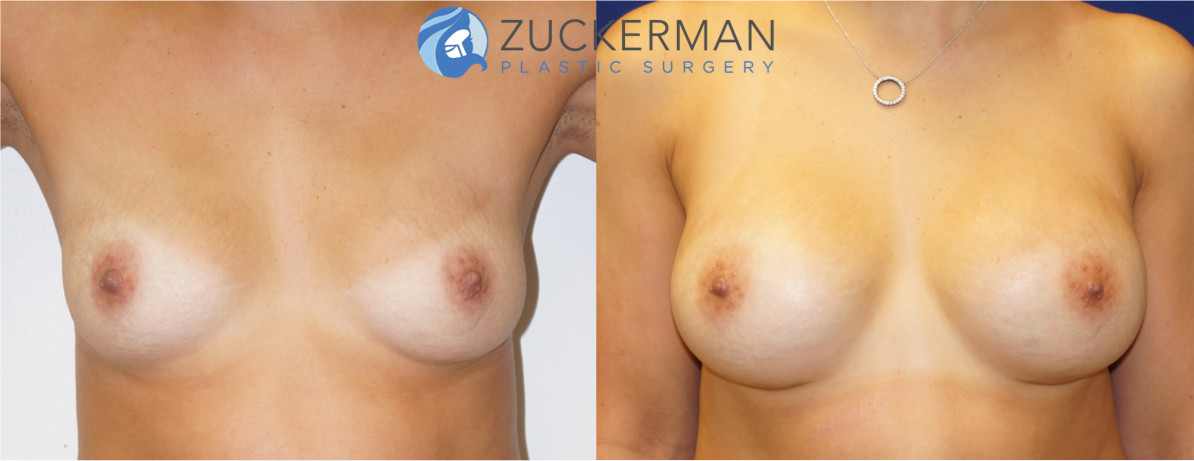
Breast augmentation by Dr. Zuckerman, female patient, 1 year post-op. Mentor Smooth Round Moderate-Plus Profile 325cc implant on the right, 350cc on the left to correct existing breast asymmetry.
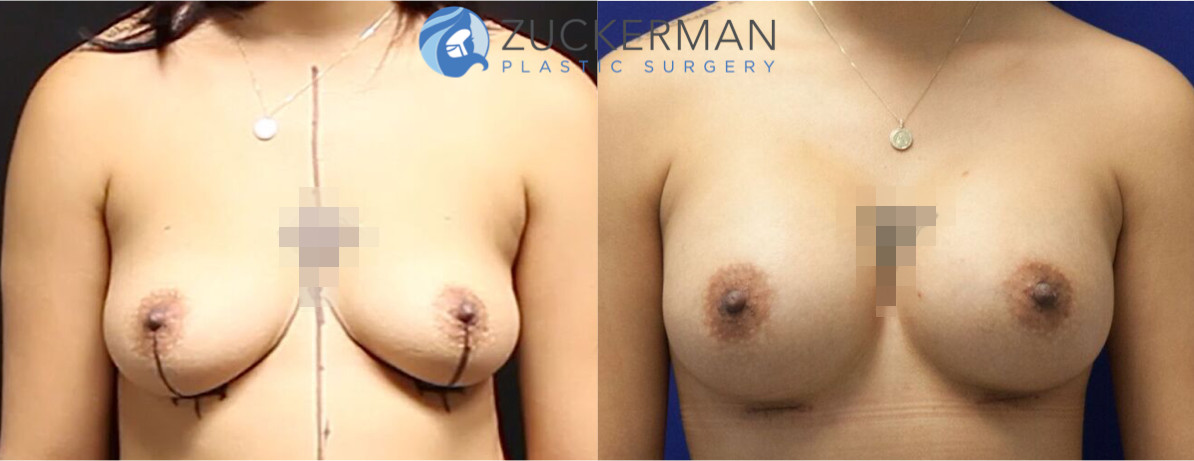
Breast augmentation by Dr. Zuckerman, female patient, 2 months post-op with 300cc silicone breast implants. Submuscular placement. Inframammary fold incision.
More Before & Afters
Dr. Zuckerman publishes many of his previous breast augmentation results with patient consent. The before and after image gallery has pairs of high resolution images from three to four angles for each patient. Many prospective patients enjoy finding a similar case to their own that Dr. Zuckerman has performed in the past. Take a look through the gallery by clicking on the button below.
Dr. Zuckerman is a highly skilled and experienced plastic surgeon who takes every precaution to ensure your safety. Breast augmentation is an extraordinarily safe procedure, but every cosmetic surgery has risks and potential complications even if low probability. These may include:
- Implant rupture or leakage, which is rare but higher risk with saline.
- Visible wrinkling or rippling, which is more common with saline.
- Asymmetry
- Scarring
- Pain
- Infection at the incision site
- Capsular contracture, which is hardening of the fibrous tissue in the breast pocket.
Common reasons for reoperation in breast augmentation mostly involve poor prior surgical technique in the first procedure and may include: development of ptosis (sag) of the breasts possibly due to poor placement, implant malpositioning possibly due to poor surgical technique or the need for a mastopexy when none was performed, wound-healing problems due to overaugmentation, or dissatisfaction with size or dimensions. Consequently, Dr. Zuckerman urges you to choose a board-certified plastic surgeon who specializes in cosmetic procedures of the breast, such as himself, for your breast augmentation procedure.
Below are the answers to some questions Dr. Zuckerman most frequently receives from prospective patients. If you don’t see your question below, feel free to contact Dr. Zuckerman’s office, and a member of his staff will be glad to reach out to you.
Can I combine a breast augmentation with a tummy tuck or liposuction?
Yes, combining a breast augmentation with a tummy tuck or liposuction is very common and is known informally as a mommy makeover, because many women suffer from deflated or sagging breasts and excess abdominal skin or muscle separation after pregnancy and breastfeeding.
What is the youngest age I can undergo breast augmentation?
Saline implants are FDA-approved for use in those 18 years and older, whereas silicone are approved for those 22 years and older. I generally recommend that a prospective patient wait until their breasts have finished growing before undergoing breast augmentation. This depends from patient to patient, but the breasts may continue to grow into a woman’s early twenties.
Subglandular versus submuscular placement?
I use the submuscular most among breast augmentations I perform, but I have recommended the subglandular placement to very fit, athletic patients with little starting breast tissue. In this case, the patient most likely has an active pectoralis muscle. Subglandular is an older placement, and it has somewhat fallen out of favor today.
How common is breast asymmetry and can it be addressed with breast augmentation surgery?
Most women actually have some degree of breast asymmetry. If your breast asymmetry bothers you, you might be well served by a breast augmentation. For augmentation, I would not want to place a single implant on one side, but it is common to place implants of different sizes in the left versus right breast.
Risks of breast augmentation for people prone to keloids?
Keloid scarring involves overly aggressive scar formation and may involve scar tissue larger than the original wound. Patients at risk for keloid formation can still undergo breast augmentation, but please let Dr. Zuckerman know about this risk as there would then be a risk of developing keloids at the breast augmentation incision sites. Dr. Zuckerman can help manage this risk via meticulous closure and a tailored postoperative scar care regimen possibly including steroid injection at the sites during healing. Risk for keloids, however, does not necessarily put the patient at higher risk for capsular contracture.
Breast augmentation before pregnancy and breastfeeding?
Breast augmentation does not impair your ability to breastfeed a child or to become pregnant.
Breast augmentation after breastfeeding to correct breast deflation, sag, or decrease in size?
Both pregnancy and breastfeeding can result in permanent changes to breast shape and size. During pregnancy and lactation, breast volume increases significantly with weight gain and the engorgement of the milk ducts. Subsequently, after weaning, breast “deflation” may occur, including loss of upper pole brast fullness. To restore an aesthetically attractive breast shape, women may either undergo a breast augmentation or a combined augmentation plus breast lift (mastopexy).
Will weight loss after breast augmentation affect my result?
As the breast is one of the more weight-sensitive areas of the body, you can expect some degree of change in their appearance with significant weight loss. The degree of this change will depend on the amount of your own breast tissue that was present before your augmentation: a greater change with more pre-op breast, lesser change with a smaller breast before surgery.
Can breast augmentation improve the appearance of stretch marks?
Stretch marks are a result of tearing of the fascia, the connective tissue under the skin. Unfortunately, breast augmentation does not address the fascia and therefore does not do much to improve its appearance. However, breast augmentation may stretch the stretch marks and make the change in color and texture less obvious.
I have tuberous breasts. Can I undergo breast augmentation? (Sometimes colloquially referred to as the non-medical term tubular breasts.)
To improve the aesthetic appearance of tuberous breasts, you would need to undergo a modified breast augmentation, where Dr. Zuckerman would perform radial scoring of the breast glandular tissue and would lower the inframammary fold in addition to placing the implants. Some patients require a two-step procedure where a tissue expander is placed in the first phase.
Is there an alternative to general anesthesia for breast augmentation?
General anesthesia is the anesthetic method of choice for most breast augmentation. In a healthy patient who has undergone proper pre-op medical evaluation, and performed by a board-certified anesthesiologist in a properly accredited facility, it is extremely safe and comfortable. That said, breast augmentation can be successfully performed without true general anesthesia – by employing deep sedation with liberal use of local and regional anesthetic nerve blockade. But again, this should be performed by an anesthesiologist and surgeon who are well experienced in these methods.
Are you ready for your breast augmentation consultation with Dr. Zuckerman? He will perform a thorough evaluation of your desired outcome and needs based on your anatomy and medical history. Dr. Zuckerman will also address any questions or concerns you may have about the surgery and discuss with you the details of his approach: incision location(s), procedure length and techniques, likely operative outcome, etc. Contact his office by clicking the button below or by calling 212-231-9897. Dr. Zuckerman also offers consultations via Skype and a process for out-of-town patients to visit New York City to have surgery with him.
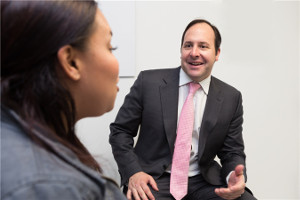
OTHER LINKS
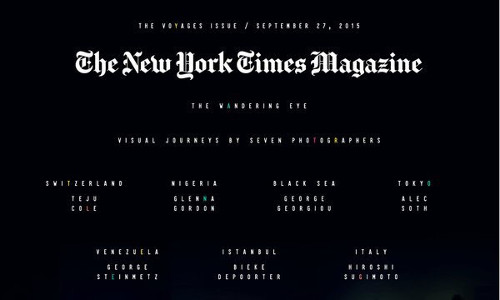
Dr. Zuckerman has been selected as a SuperDoctor and profiled in The New York Times Magazine SuperDoctors issue three years in a row.

Dr. Zuckerman was quoted on the use of Kybella to eliminate submental, under the chin, fat. He also opined on how an angular jaw line is essential to societal classical perceptions of facial beauty.

Dr. Zuckerman appeared on an episode of The Doctors TV show on CBS for a preoperative evaluation of a severe burn victim who requires a complex plastic surgery reconstruction.

A mother and daughter pair of Dr. Zuckerman’s patients were interviewed by the New York Post about how much they enjoy their experience at Dr. Zuckerman’s office, undergoing cosmetic Botox and Juvederm treatments.

Dr. Zuckerman opined on the trend of “Trophy Husbands” where men undergo plastic surgery for Fox5 News.

Dr. Zuckerman was interviewed on nipple piercings, their implications for breastfeeding, and why plastic surgery intervention may be required to remove them.

Dr. Zuckerman was selected as a SuperDoctor for New York state for plastic surgery. This selection is Dr. Zuckerman’s third year in a row and recognizes him as one of the best plastic surgeons in New York.

Dr. Zuckerman discussed the fact that liposuction is not a shortcut to weight loss. It is a sculpturing tool best used to shape and contour targeted problem areas with excess, stubborn fat.


